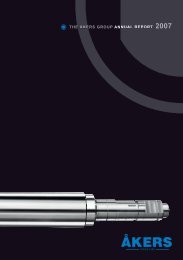CAEF Roll failures manual - The Åkers Group
CAEF Roll failures manual - The Åkers Group
CAEF Roll failures manual - The Åkers Group
Create successful ePaper yourself
Turn your PDF publications into a flip-book with our unique Google optimized e-Paper software.
5.2 Banding<br />
5.2.1 Description<br />
Heavily peeled bright areas appear on the work roll oriented in the circumferential<br />
direction and very often in the form of bands with a very rough surface. Banding typically<br />
appears on ICDP work rolls in the early finishing stands of hot mills, even after rather<br />
short campaign times. Banding is also possible, when high chrome work rolls are<br />
used after longer run times in the same critical stands and positions.<br />
5.2.2 Origin<br />
Alternating friction forces in combination with<br />
alternating thermal loads exceed the hot fatigue<br />
shear strength of the shell material. Surface<br />
parallel cracks within the depth of primary<br />
firecracks develop and propagate until<br />
the firecracked areas are sheared away from<br />
the roll. Once the roll surface is locally deteriorated,<br />
peaks of shearing forces are induced<br />
which lead to a very fast development of peeled<br />
bands around the roll barrel. <strong>The</strong> removed<br />
layer has a depth of about 0.1 to 0.2mm<br />
which more or less corresponds to the depth<br />
of the primary firecracks.<br />
This phenomenon is mainly related to mill<br />
conditions.<br />
5.2.3 Remedy<br />
Adjust the campaign length to change work rolls before appearance of banding.<br />
Factors of importance are:<br />
• roll grade<br />
• interstand cooling<br />
• skin cooling<br />
• lubrication<br />
• reduction<br />
• roll cooling<br />
• rolling pace<br />
23<br />
Section 5 SURFACE CONDITION IN ROLLING




